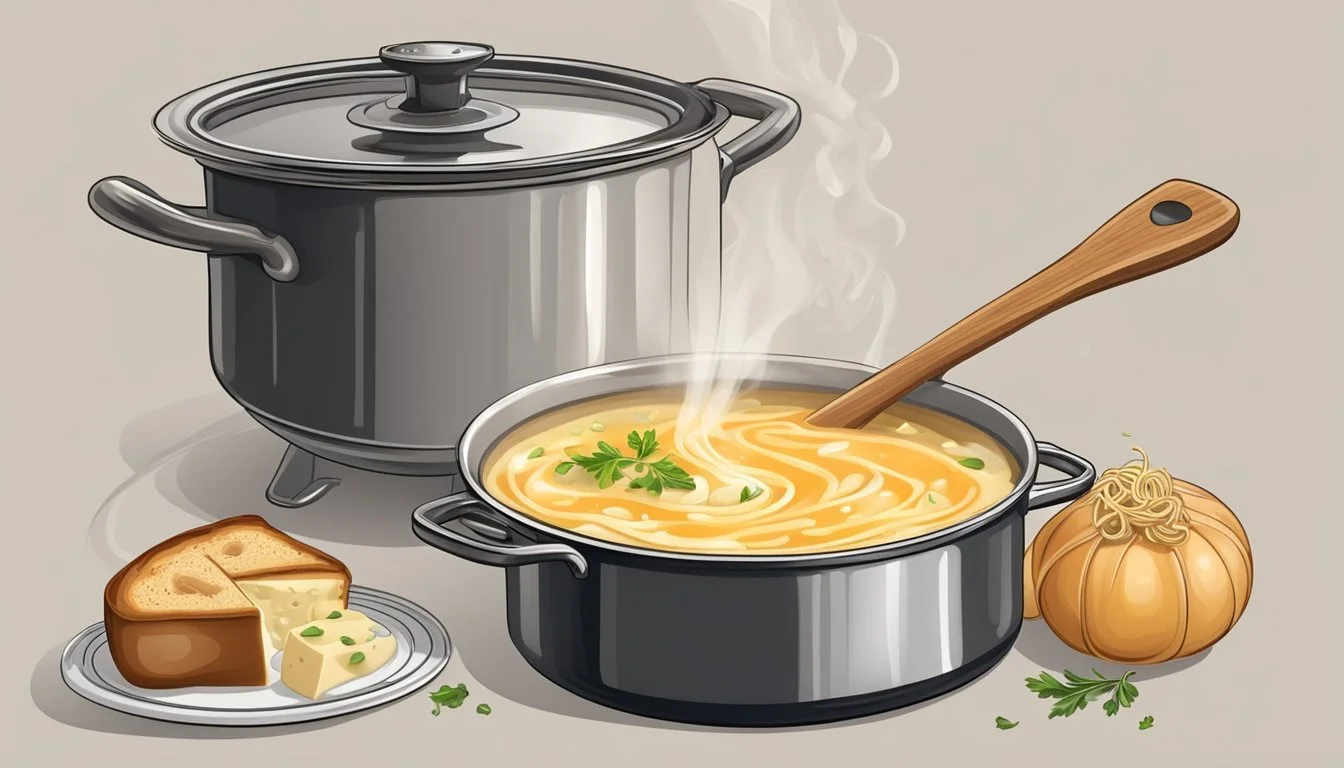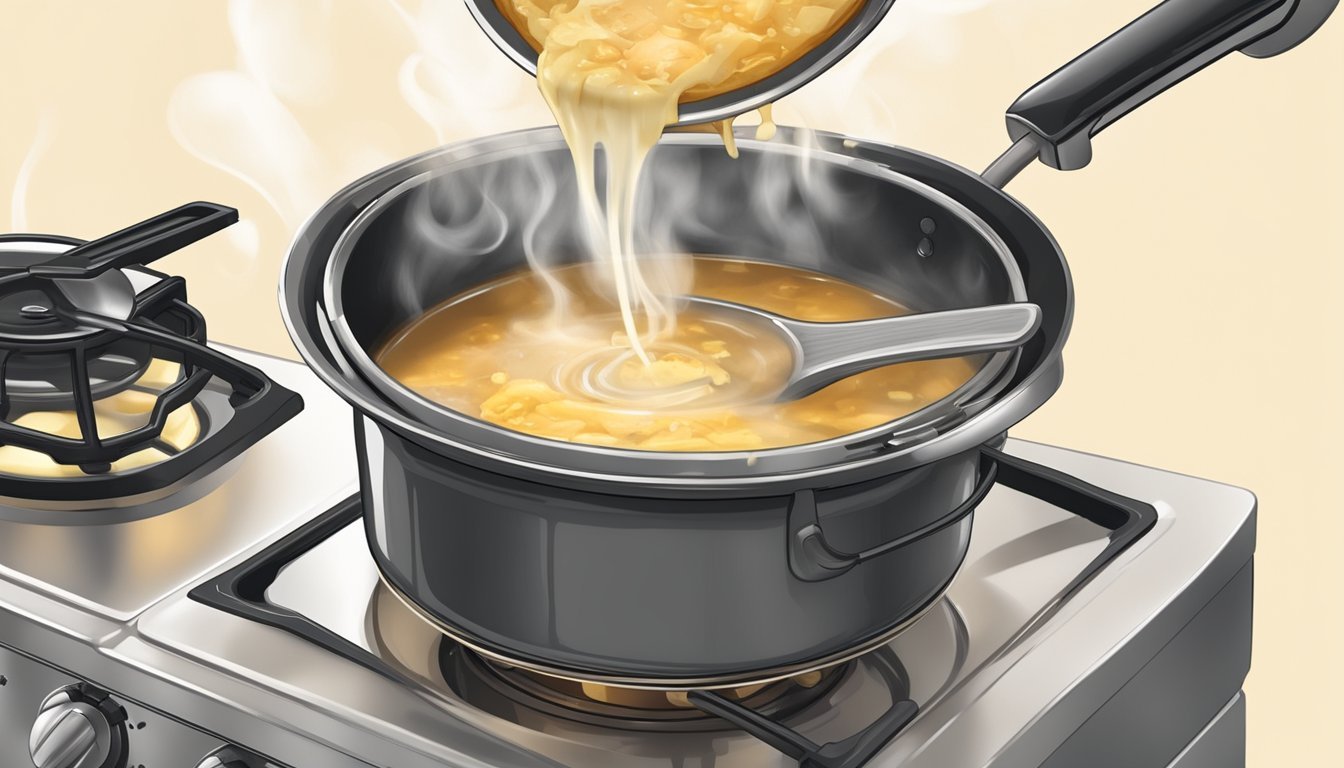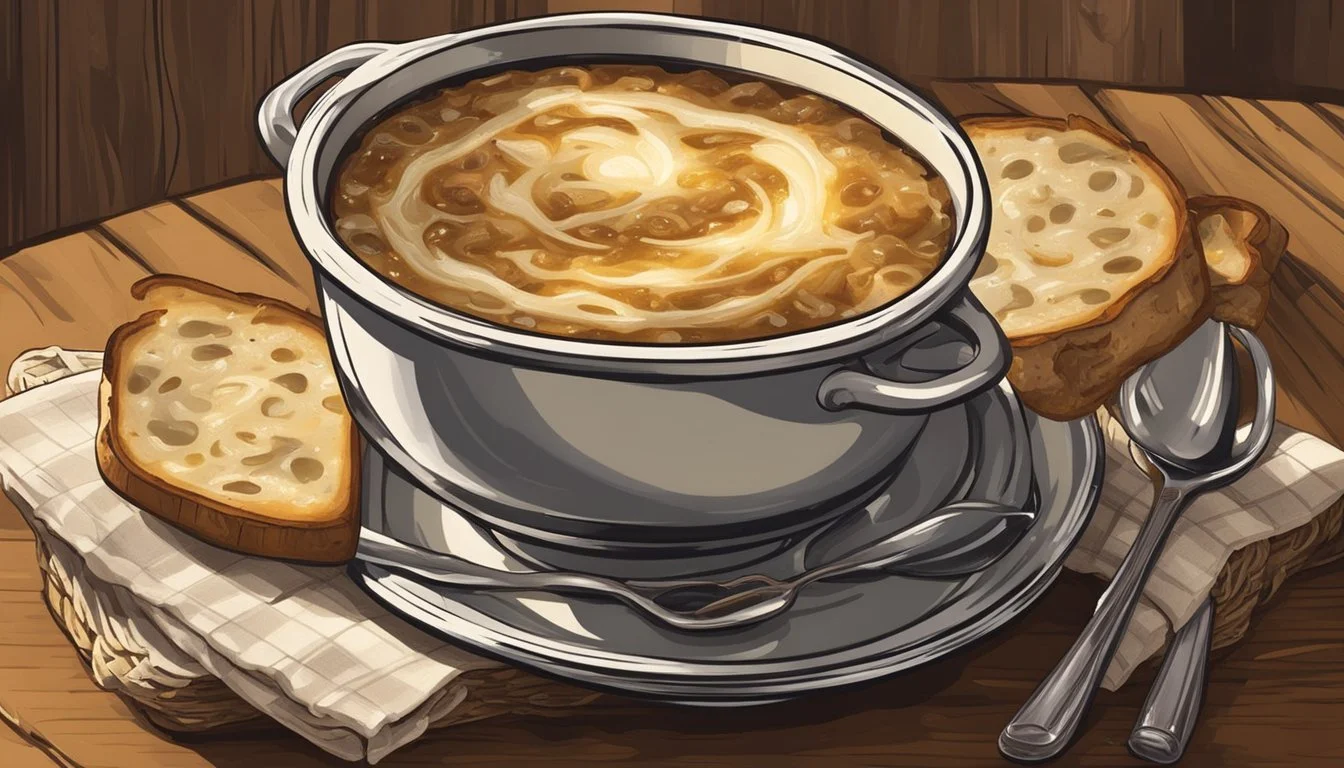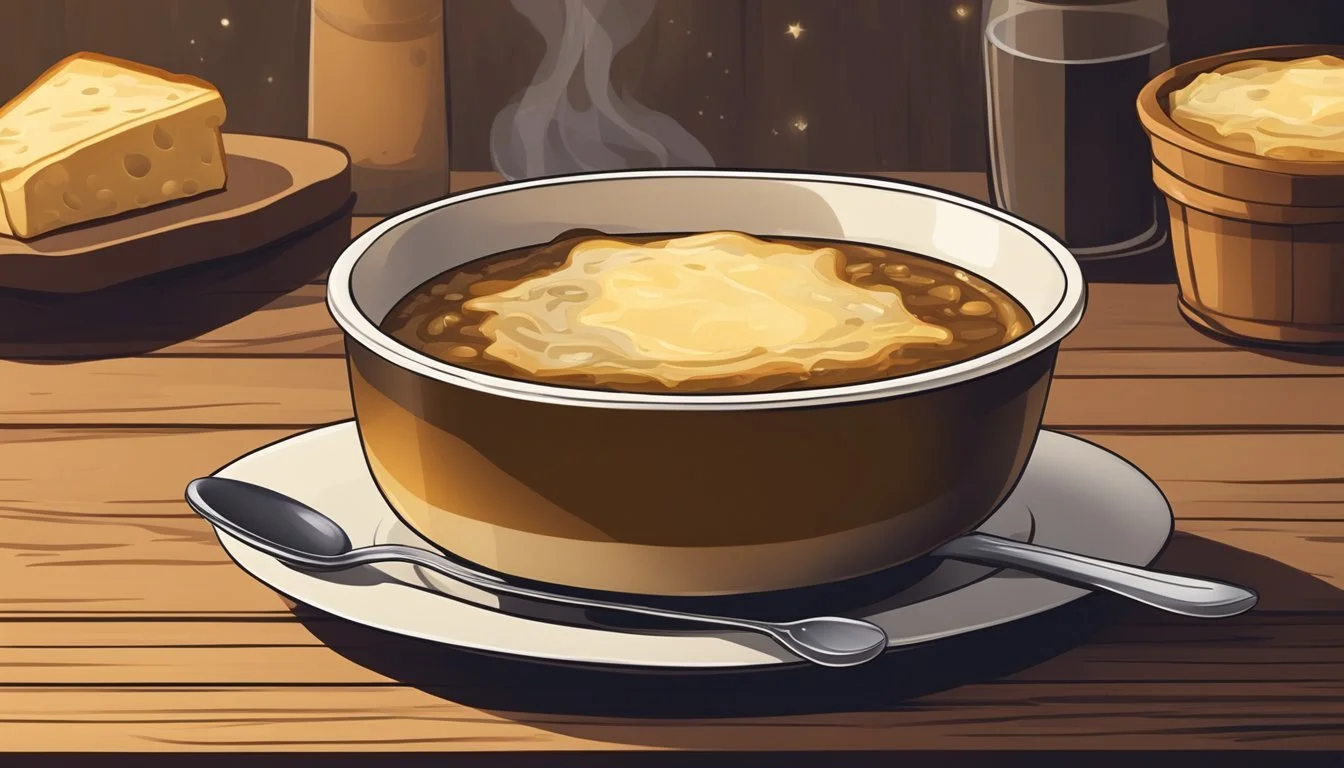Best Way to Reheat French Onion Soup
Preserving That Rich Broth Flavor
French onion soup, with its rich broth, melted cheese, and satisfyingly crunchy croutons, presents a unique challenge when it comes to reheating. The key objective when warming up this classic dish is to maintain the integrity of its flavors and textures. Broth-based soups (What wine goes well with soups?) can often lose their depth of flavor when reheated improperly, but with the right techniques, one can restore the soup to its original glory without compromising the taste.
Reheating French onion soup requires careful attention to detail to preserve the aromatic broth and amalgamate the melted cheese and bread into the soup just as it was when freshly made. Various methods, such as the microwave, stovetop, and oven, offer different benefits in ensuring the soup reaches the perfect eating temperature. Each technique demands a specific approach to prevent the overcooking of ingredients and to ensure the cheese retains its stringy, gooey quality.
Understanding French Onion Soup
French Onion Soup is a classic bistro dish known for its deep, rich flavor and comforting qualities. At its core, the soup combines caramelized onions, flavorful broth, and usually a splash of wine, simmered together to create a harmonious blend of tastes. A traditional French Onion Soup recipe will typically include the following main ingredients:
Onions: The star of the dish, they are slowly cooked until they are deeply caramelized, bringing out natural sweetness.
Broth: Typically made with beef broth, though chicken stock can be used as an alternative. It serves as the soup's base, contributing to its robust flavor.
Wine: A dry white or red wine is often added. It helps to deglaze the pan and add complexity to the dish.
Butter: Used to cook the onions, butter adds richness.
Seasonings: A combination of thyme, salt, pepper, and perhaps a hint of sugar to balance the onions' acidity.
Bay Leaves: Often included in the simmering process to introduce additional aromatic qualities.
When prepared with attention to detail, the soup presents a perfect balance of savory and sweet elements, underlined by the subtle hints of thyme and bay leaves. The process of caramelization is key in coaxing out the onions' natural sugars, which is why patience is vital when preparing French Onion Soup. It's these intricately layered flavors that can be challenged during the reheating process, leading to the risk of altering the soup's intended taste and aroma.
Pre-Reheating Fundamentals
Proper storage and preparation lay the groundwork for reheating French onion soup while retaining its rich broth flavor. These essentials ensure safety, preserve quality, and streamline the reheating process.
Storing French Onion Soup
To maintain the integrity of French onion soup, storing it correctly is crucial. Refrigerator: For short-term storage, place the soup in an airtight container and keep it in the refrigerator, where it can last up to four days. Freezer: For long-term storage, pour the soup into a freezer-safe container or freezer bags, carefully removing excess air before sealing to prevent freezer burn. It's best to consume frozen French onion soup within 2-3 months for optimal taste.
Safety and Preservation
Keeping French onion soup safe to eat involves managing temperature and bacteria. Defrost frozen soup in the refrigerator to maintain a controlled thawing environment. Always stir the soup when reheating to ensure even temperature distribution, as uneven heating can promote bacterial growth. Before storing or freezing, cool the soup quickly to decrease the risk of bacterial contamination.
Prep Time and Ingredients Preparation
Before reheating, gather all the necessary ingredients for the signature French onion soup toppings. Standard toppings include sweet onions, caramelized onions, cheese, and crostini or croutons. Having these prepared in advance will streamline the reheating process. Also, ensure you have a full-bodied wine on hand if it's part of your recipe—the right wine enriches the broth's flavor during reheating.
Effective Reheating Techniques
To ensure the French Onion Soup retains its rich flavor and avoids becoming too watery or dry, careful reheating techniques must be employed. Each method detailed below serves to warm the soup thoroughly while maintaining its savory taste.
Stovetop Method
Using a stovetop allows for better control over the heating process. The soup should be placed in a pot and warmed over low heat. It's important to frequently stir the soup to prevent it from sticking to the bottom of the pot and to achieve even heating. Allow the soup to simmer until it reaches the desired temperature.
Oven Reheating
Oven reheating is ideal for replicating the original texture of the soup. First, preheat the oven to 350°F (180°C). Pour the soup into an oven-safe dish and cover it with aluminum foil to retain moisture. Bake the soup for about 10-20 minutes. For an added touch, place a piece of bread topped with cheese on the soup and broil for a few minutes until the cheese bubbles.
Microwave Heating
For a quicker option, the microwave can be used. Transfer the soup into a microwave-safe bowl, covering it to prevent splatters, and heat on high. Warm the soup in intervals of 2-3 minutes, stirring between each interval to promote even heating. Continue until the soup reaches the preferred temperature.
Adding the Finishing Touches
The final steps in reheating French onion soup are crucial for achieving the perfect combination of flavor and texture. These involve preparing the bread and cheese toppings and ensuring the presentation highlights the soup's hearty appeal.
Cheese and Bread Toppings
When the soup is thoroughly heated, it is essential to add the traditional cheese and bread toppings that characterize French onion soup. The cheese used should ideally be Gruyère, Swiss, Comté, or a mix, all of which are known for their superb melting qualities. Grated cheese should be generously layered on top.
For the bread, select a slice of toasted baguette or country-style bread. The bread acts as a platform for the cheese and provides a pleasant crunch. The bread can be either placed directly in the broth or toasted separately and added just before serving.
Bread Options:
Baguette
Country-style bread
Cheese Options:
Gruyère
Swiss cheese
Comté cheese
Carefully ladle the hot soup into heatproof bowls before adding the bread and cheese toppings. This helps to prevent the bowls from cracking due to the heat.
Serving and Presentation
Once the cheese and bread are added, place the heatproof bowls under a broiler. Monitor closely to melt the cheese until it's bubbly and lightly browned, creating a melted cheese topping that is visually appealing and delicious.
Broiling Steps:
Place bowls under broiler.
Broil until cheese is bubbly and slightly golden.
The presentation of French onion soup is not complete without appropriately toasty bread and perfectly melted cheese. Serve immediately to ensure guests enjoy the full spectrum of flavors and textures, from the savory broth to the gooey, toasted cheese topping.
Maintaining Soup Quality
When reheating French Onion Soup, preserving the rich flavor and texture of the broth is paramount. Here are some key points to ensure quality is maintained:
Flavor Preservation: Reheating should be done gently to retain the soup's complex flavors. A slow simmer on the stove can achieve this without loss of taste.
Texture Consideration: To ensure the broth maintains its consistency, avoiding overcooking is critical. Overcooking can alter the texture and create an undesirable effect.
Liquid Management: When reheating, some liquid may evaporate. Adding a small amount of water or stock can compensate for this loss without diluting the flavor significantly.
Heat Control: Always use low heat when reheating to prevent altering the soup's taste and to avoid burning the bottom.
Best Practices for Reheating:
Stovetop Simmering
Heat the soup in a pot over low heat.
Stir occasionally to distribute heat evenly.
Oven Reheating
Place the soup in an oven-safe dish.
Cover with aluminum foil to prevent excessive evaporation.
Reheat at a low temperature (around 325°F).
By following these methods, one can maintain the integrity of the French Onion Soup during reheating, ensuring that the final product is as enjoyable as when it was first prepared.
Post-Reheating Tips
After expertly reheating French onion soup, it's crucial to focus on enhancing the flavor and properly storing leftovers to maintain quality.
Optimizing Soup Taste
Seasoning Adjustment: Reheating can sometimes dilute flavors. To counteract this, one should taste the soup and adjust seasoning accordingly. A pinch of kosher salt or a twist of freshly ground black pepper can revitalize the soup's depth.
Note on Salt: Use salt sparingly; too much can overpower the delicate onion notes.
Layering Flavors: For an added touch, consider a hint of fresh herbs or a drizzle of quality olive oil to bring a zest of freshness back to the heated soup.
Leftover Storage Solutions
Refrigeration: One should store any leftover soup in an airtight container and place it in the refrigerator. This can keep the soup good for 3-4 days.
Reminder: Cool the soup to room temperature before storing to maintain the safety and taste.
Freezing: If one needs more extended storage, freezing is an option. Pour the soup into a suitable container, leaving enough space to accommodate expansion as it freezes. It's best to consume frozen soup within 2-3 months for optimal taste.
Defrosting: Thaw the soup overnight in the refrigerator before reheating to ensure even warming and preservation of flavors.
Frequently Asked Questions
Can French onion soup be reheated?
Yes, French onion soup can be reheated. It is recommended to reheat the soup gently to preserve the flavor of the broth.
What's the best method to reheat French onion soup?
The best methods include:
Microwave: For a quick reheat, transfer the soup to a microwave-safe bowl, cover, and heat on high for 2-3 minutes.
Oven: Preheat to 350ºF (180ºC), place the soup in an oven-safe dish, cover with foil, and heat for 10-20 minutes.
Should toppings be added before or after reheating?
Toppings, like cheese and bread, should be added after reheating and then placed under the broiler for a couple of minutes until the cheese melts and is bubbly.
How can I freeze and thaw French onion soup?
To freeze, cool the soup completely and store it in airtight containers. For thawing, refrigerate it overnight or reheat directly from frozen, adding extra time.
Are there pros and cons to the different reheating methods?
Microwave:
Pros: Quick and convenient.
Cons: Can unevenly heat and potentially impact broth flavor.
Oven:
Pros: Evenly heats and maintains flavor.
Cons: Takes longer than microwave.
Is it safe to reheat French onion soup more than once?
It is generally safe if properly stored and reheated to the right temperature, but it may affect quality and flavor. Reheat only the portion you intend to consume.
French Onion Soup Variations
French Onion Soup is a classic French dish renowned for its rich broth, caramelized onions, and melted cheese. The traditional recipe involves slow cooking the onions, adding a base of beef or chicken stock, and topping it with a slice of crusty bread and melted Gruyère cheese. Here are some variations to consider:
Cheese Alternatives: Though Gruyère is the traditional choice for its melting quality and flavor, one can also try Emmental, Mozzarella, or Provolone for different nuances of taste.
Vegetarian Twist: Replace traditional beef stock with a robust vegetable stock to cater to vegetarian preferences without compromising on the soup’s depth of flavor.
Cooking Methods:
Method Cook Time Notes Stovetop 45-60 mins Classic method; allows for easy caramelization of onions Slow Cooker 4-10 hours Long cook time; flavors meld exceptionally well
Calorie Conscious: To reduce the soup's calorie content, opt for low-fat cheese or reduce the amount of cheese. Additionally, consider using less oil or butter for sautéing the onions.
Each method retains the essence of French onion soup—caramelized onions in a savory broth—while allowing for personal adaptation that respects the soup's origins in France. One can experiment with these variations to alter the cook time, flavor profile, and caloric intake, ensuring each bowl of French Onion Soup brings a hearty and satisfying experience.
Pairings and Serving Suggestions
When reheating French onion soup, complementary drink pairings and side dishes can significantly enhance the dining experience. The following suggestions aim to maintain the balance of flavors and the cozy charm of this classic comfort food.
Drink Pairings
Wine:
For those enjoying a bowl of French onion soup, a dry red wine such as a Cabernet Sauvignon or a Merlot can complement the richness of the broth. These wines offer a robust flavor profile that matches well with the hearty nature of the soup.
Sherry:
A glass of sherry also pairs nicely. Its crisp and nutty flavor not only complements the savory elements but can also cut through the richness of the cheese atop the soup. Opt for a dry variety to avoid clashing with the soup's flavor.
Side Dish Recommendations
Simple Salad with Balsamic Vinegar:
A light salad, dressed with balsamic vinegar, offers a refreshing contrast to the soup’s deep flavors. The acidity of the vinegar balances the sweetness of the caramelized onions and cleanses the palate between spoonfuls.
Bread Varieties:
Baguette: Ideal for dipping, offering a satisfying crunch.
Garlic Bread: Adds a zesty flavor dimension.
Cheese-Topped Crostini: Echoes the melted Gruyère and provides textural contrast.
In serving French onion soup, one should keep the accompaniments simple to allow the complex flavors of the soup to be the star of the meal.







